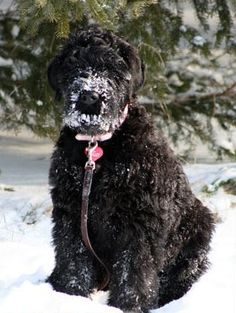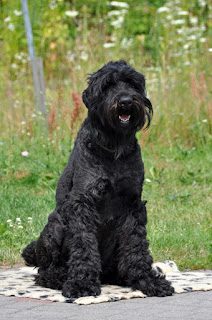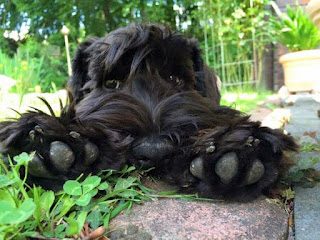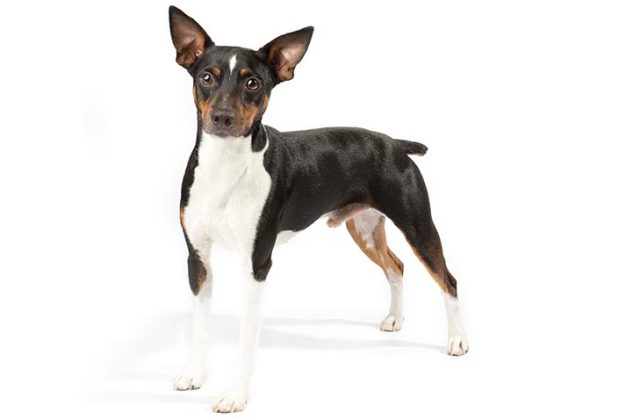- The Black Russian Terrier’s coat is slightly to moderately wavy. The hair on the head falls over the eyes and on the face forms a mustache and beard. The coat is trimmed to achieve the dog’s distinctive look.
- Basic black is this breed’s fashion statement. His double coat – which can be one and a half to six inches long – comes only in black or black with a few gray hairs scattered throughout.
AKC group: Working
UKC group: Guardian Dog
Average lifespan: 10-14 years
Average size: 80–130 pounds
Coat appearance: Rough and thick, slightly waved
Coloration: black coats, but a sprinkling of gray hair
Hypoallergenic: No
Best Suited For: Families with children, active single, houses with yards, farms and rural areas
History
This dog is a Cold War creation, developed in Moscow after World War II for military and police work. His breeders started with a
Giant Schnauzer and crossed him with other breeds that included the
Airedale,
Rottweiler, and the Moscow Retriever. The result was a large black dog with a protective temperament and a healthy dose of suspicion toward strangers.
Less than two decades ago, the BRT was seen only in small numbers at European and Scandinavian dog shows, but in 2004 he was recognized by the American Kennel Club as its 151st breed. Today the Black Russian Terrier ranks 135th among the breeds registered by the AKC.
Black Russian Terriers are truly man’s best friend. They thrive on human interaction and have such a strong desire to be with their family that they will follow their people from room to room, and when left alone, will wait longingly by doors or windows until they are happily reunited with the ones they love. This breed adores children – especially female Black Russians. They are patient with small children who want to climb on them and are big enough to keep up with bigger kids’ outdoor games. They have bee known to sleep in kids’ rooms or outside their bedroom doors as a guardian and protector.
Health
The Black Russian Terrier, which has an average lifespan of 10 to 14 years, is prone to minor health issues such as elbow dysplasia and major problems like canine hip dysplasia (CHD). The breed may also suffer from progressive retinal atrophy (PRA) and dwarfism. To identify some of these issues, a veterinarian may recommend hip, elbow, and eye exams for the dog
Care
The Black Russian Terrier, because of its breeding as a working dog, has a very strong “work ethic”, and needs a job to do in order to be happy. Early training is a must and they are very responsive to firm, consistent training, excelling at Obedience competitions. They also perform well in other dog sports, such as Agility, and Schutzhund training. They have a low-shedding coat, and need grooming several times a week. Dogs who compete in conformation need to be groomed a minimum of every three weeks to keep the coat in show condition. The Black Russian Terrier needs lots of exercise, and may become hyperactive and destructive if it does not have a chance to burn off its energy..
The Black Russian Terrier will do okay in an apartment if it is sufficiently exercised. They are relatively inactive indoors and no matter how big your yard is they will be sitting at your front door waiting to come in. They love to live very close to their owner. They will follow you from one room to the other. Kept in a garden they will follow you from window to window and wait for you at the door. They need very close human contact. This breed does not do well living in a kennel; they must have close human contact to be happy.
Training
Black Russian Terriers are extremely intelligent and eager to please and are fairly easy to train. They do however have strong personalities and should be handled with a loving but firm hand from an early age. BRT puppies are inquisitive and playful and some adults too display this extreme curiosity. Black Russian Terriers often excel at various obedience competitions and dog sports such as agility and Schutzhund training.
Black Russian Terriers, despite their larger size, can do well living in an apartment. They don’t need an excessive amount of vigorous running time per day, but do need several walks. If left alone in a yard, Black Russian will quickly get bored and want to come inside. Outside activities should always involve interaction with kids or people in order to keep this breed interested.
Grooming
Regular grooming is essential for the Black Russian Terrier’s handsome good looks. Expect to bathe your dog every two to three months. The wiry coat should be brushed twice a week to prevent tangles.
The rest is basic care. Nails should be trimmed once a month and ears checked every week. Regular tooth brushing with a soft toothbrush and doggie toothpaste keeps the teeth and gums healthy.
Because the Black Russian Terrier is not a common breed, it is likely some professional groomers will not know exactly how to groom him, especially when it comes to hand stripping. An experienced breeder is probably the best resource for learning how to groom the breed.
 It is important to begin grooming
It is important to begin grooming the Black Russian Terrier when he is very young. An early introduction teaches this independent dog that grooming is a normal part of his life and to patiently accept the grooming process.
Children And Other Pets
Despite their impressive size, Blackies are great with children and will protect them. Females seem more willing to play with children than the males, but both sexes treat children with whom they are raised with gentleness and respect. Don’t forget, however, that Blackies are large and active companions, and extremely young children may be accidentally knocked over or injured by a playful and energetic dog of this size. Use caution with very young children.
Blackies who have not been exposed to children from puppyhood may not be as tolerant-something to consider if you’re looking to add an older or rescue dog to your household.
Either way, you should always teach children how to approach and touch dogs, and always supervise any interactions between dogs and young children to prevent any biting or ear or tail pulling on the part of either party. Teach your child never to approach any dog while he’s eating or sleeping or to try to take the dog’s food away. No dog, no matter how friendly, should ever be left unsupervised with a child.
Make sure your Blackie is well socialized as a puppy and adult so that he doesn’t become overprotective of his family and property.
Male Black Russians don’t do well with other dominant dogs. Many of them aren’t suited to dog parks for this reason. At home, they do best with other canine companions who were already established in the house. They will be fine with nondominant or small dogs, as well as cats, horses, rabbits, and other pets.
Is the Black Russian Terrier the Right Breed for you?
 Moderate Maintenance
Moderate Maintenance: Regular grooming is required to keep its fur in good shape. Professional trimming or stripping needed.
Minimal Shedding: Recommended for owners who do not want to deal with hair in their cars and homes.
Moderately Easy Training: The Black Russian Terrier is average when it comes to training. Results will come gradually.
Fairly Active: It will need regular exercise to maintain its fitness. Trips to the dog park are a great idea.
Not Good for New Owners: This breed is best for those who have previous experience with dog ownership.
Good with Kids: This is a suitable breed for kids and is known to be playful, energetic, and affectionate around them.
Did You Know?
Despite the word Terrier in his name, the Black Russian Terrier is a member of the American Kennel Club’s Working Group.
 Moderate Maintenance: Regular grooming is required to keep its fur in good shape. Professional trimming or stripping needed.
Moderate Maintenance: Regular grooming is required to keep its fur in good shape. Professional trimming or stripping needed.






